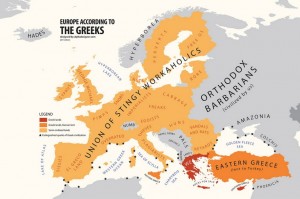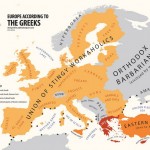Worried About the Euro? Try Bitcoin.

Got any bitcoins?
With the serial crises in the Euro zone, one has to wonder if the currency will survive. If it doesn’t, one assumes that individual countries will return to their national currencies: the drachma, lira, peseta, etc. But do they have to? Who says that a currency has to be sponsored by a national government?
That’s part of the theory behind Bitcoin, the most successful virtual currency in history. Bitcoins exist as highly encrypted computer transactions. The currency was created in 2009 by an extremely talented programmer (or programmers) using the pseudonym Satoshi Nakamoto. Roughly 31,000 lines of very tightly written code generate 2½ bitcoins per minute. (The rate will vary over time until 21 million bitcoins are produced). Bitcoin enthusiasts use high-powered servers to “mine” the bitcoins; they usually sell them on exchanges like Mt. Gox. The system uses the same servers to track transactions and ensure that no one person can spend the same bitcoin twice.
The bitcoin system uses peer-to-peer networking, meaning that there’s no central office or person or committee responsible for managing operations. That also means there’s no one to arrest if national authorities decide that the operation is illegal (which, so far, they haven’t). As Nakamoto pointed out in an early manifesto, today’s fiat currencies require us to trust national governments and central banks, which seem to regularly abuse that trust. The bitcoin, on the other hand, is based on “crypto proof instead of trust.” If you trust cryptography more than you trust central banks, the bitcoin is for you.
Bitcoins have all the advantages of cash, including anonymity. They also remove most of the disadvantages of cash: you can’t lose them, they (apparently) can’t be stolen, and they’re not bulky and hard to transfer. Because there’s no middle man, transaction costs are also very low. Anonymity and ease-of-use appeal to three significant demographics: libertarians, criminals, and those who predict the collapse of national currencies.
The never-ending euro crisis has driven bitcoins to new heights of popularity. There are now roughly 10.5 million bitcoins in circulation. Like a commodity, their price is governed by supply-and-demand. Since the Cyprus crisis erupted, their value has nearly tripled and they recently sold for about $105 each — meaning that the total value of bitcoins in circulation is now over $1 billion.
Their popularity has expanded in other ways as well. Search for “bitcoin” on Amazon and you’ll find 54 different publications. There’s also a magazine, which has a good overview article (complete with common misconceptions). Canada is even experimenting with a virtual currency called the MintChip which may have many of the features of Bitcoin but with the backing of a national government. The hype is accelerating and, as Andrew Leonard points out in Salon, that may be the beginning the end. Because of its growing popularity, the Feds are now starting to pay attention.
The best introduction to bitcoins is probably Joshua Davis’ article in The New Yorker in October 2011. Davis provides a very good layman’s summary of bitcoin operations and also attempts to track down Satoshi Nakamoto. In an article in Fast Company, Adam Penenberg, also tries to identify Nakamoto and comes up with a trio of possibilities — not the same suspects that Davis identifies.
It’s fun to speculate where all this might lead. So far, I haven’t bought any bitcoins. The value has gone up so much in recent months that it seems like a bubble. I am curious, however, if any of my readers have bought and spent bitcoins. If so, be sure to let us know about your experiences.
Culture – Masculine/Feminine
 Would you prefer to: 1) work the same number of hours and earn more money, or; 2) work fewer hours and earn the same money? According to Geert and Gert Jan Hofstede this question can help us ascertain whether a culture is “feminine” or “masculine”.
Would you prefer to: 1) work the same number of hours and earn more money, or; 2) work fewer hours and earn the same money? According to Geert and Gert Jan Hofstede this question can help us ascertain whether a culture is “feminine” or “masculine”.
The Hofstedes are academic researchers who study the influence of national cultures on organizational behavior. The Hofstedes write that there are five basic dimensions of culture: 1) power distance — the degree of equality/inequality in a culture; 2) individualist/collectivist continuum; 3) masculine/feminine; 4) Uncertainty avoidance — the degree to which we believe that what’s different is dangerous; 5) short-term/long-term orientation. I’ve written about the first two previously (here and here). Today, let’s talk about masculine/feminine. I’ll cover the other two in the near future.
According to the Hofstedes, the masculine/feminine dimension has mainly to do with the degree of differentiation between gender roles. In “masculine” cultures, “…gender roles are clearly distinct: men are supposed to be assertive, tough, and focused on material success, whereas women are supposed to be modest, tender, and concerned with the quality of life.” In “feminine” cultures, “… gender roles overlap: both men and women are supposed to be modest, tender, and concerned with the quality of life.”
As with their other dimensions, the Hofstedes develop a scale (MAS) and rank order 74 countries. The five most “masculine” countries are Slovakia (MAS = 110), Japan (95), Hungary (88), Austria (79), and Venezuela (73). The most “feminine” countries are Sweden (MAS = 5), Norway (8), Netherlands (14), Denmark (16), Slovenia (19). The United States has an MAS score of 62, making it the 19th most “masculine” country on the list.
The masculine/feminine dimension is the only one of the five dimensions that is not correlated to national wealth. In general, wealthier nations tend to have smaller power distance (more egalitarian), lean toward individualism, are more comfortable with uncertainty, and have a long-term orientation. The masculine/feminine dimension, on the other hand, has no relationship to wealth. We see rich and poor masculine cultures and rich and poor feminine cultures in approximately equal proportions.
In very general terms, masculine cultures are about ego, feminine culture are about relationships. In masculine cultures, status purchases (expensive watches, jewelry) are common and people buy more nonfiction books. In feminine cultures, people buy more products for the home, invest more in do-it-yourself projects, and buy more fiction. In masculine societies, failure at school is a catastrophe and may lead to suicide. In feminine societies, school failure is a relatively minor incident. In masculine societies, competitive sports tend to be part of a school’s curriculum; in feminine societies, they are extracurricular.
In the workplace, the masculine/feminine continuum produces important differences in work content and management styles. In masculine cultures, we might hear people say, “I live to work”. In feminine cultures, we’re more likely to hear, “I work to live”. Answering the opening question (above), masculine societies tend to prefer more salary for the same hours; feminine societies prefer the same salary for fewer hours.
Job enrichment also varies by culture. In masculine societies, enrichment largely means more opportunities for advancement, recognition, and challenge. In feminine societies, enrichment is more about relationship building and mutual support. In feminine cultures, small is beautiful. In masculine cultures, bigger is better. In feminine societies, careers are optional for both genders. In masculine societies, careers are mandatory for men, optional for women.
You can find the Hofstede’s book here.
Playing Up Creativity
 Want to be more creative? How do you get started? What are the best exercises to stimulate creativity? It all sounds very serious. As it turns out, it may not be so serious after all. The basis of creativity may simply be unstructured play.
Want to be more creative? How do you get started? What are the best exercises to stimulate creativity? It all sounds very serious. As it turns out, it may not be so serious after all. The basis of creativity may simply be unstructured play.
That’s the argument that the International Play Association (IPA) makes. According to the IPA white paper Children’s Right to Play, when children play, they “…rearrange their worlds to make them either less scary or less boring.” They also learn how to negotiate, the importance of rules, and a general notion of fairness. It’s not so much rehearsal for adult life (as I had thought). Rather, it’s “about creating a world in which … children are in control and can seek out uncertainty in order to triumph over it — or, if not, no matter, it is only a game.”
The IPA notes that unstructured play can enhance a child’s “…adaptive capabilities and resilience” and “changes the architecture of the brain, particularly in systems to do with emotion, motivation, and reward.” For all these reasons (and more), the IPA concludes that “… play is no mere indulgence; it is essential to children’s health and well-being.” (By the way, the IPA was established in 1961 in — where else? — Denmark. Those pesky Scandinavians again!)
Note that we’re talking unstructured play, which is different than, say, playing baseball or the piano. As Melinda Wenner points out in Scientific American, structured games “… have a priori rules — set up in advance and followed. Play, on the other hand, does not have a priori rules, so it affords more creative responses.” So, taking up all your kid’s time in sports leagues or music classes may actually impede rather than develop their creativity. It’s also important to let kids play with kids. Among other things, kids use more sophisticated language when they play with each other than when they play with adults.
That’s all well and good for kids but what about those of us who are well past our prime playing days? Wenner writes that “Adults who do not play may end up unhappy and exhausted without understanding exactly why.” How should adults play? Wenner makes three suggestions:
- Body play — “participate in some form of active movement that has no time pressures or expected outcomes (if you are exercising just to burn fat, that’s not play!)”
- Object play – create something with your hands
- Social play — “join other people in seemingly purposeless social activities, ‘from small talk to verbal jousting’…”
Wenner concludes that, “Ultimately, it’s not how you play but that you play.” So enough with this website. Let’s go out and play.
(By the way, IPA next triennial conference will be in Istanbul in 2014. Anyone want to go play?)
I’m a Facebook Spammer. Apparently.

A spammer? Moi?
I run my little consulting business out of an expansive office in our basement. The business is going reasonably well — I have clients in both Sweden and the United States. Still, I have some slack time every now and again. I need to do some marketing to build the business.
So far, my marketing consists of this website, some social media, and some nice t-shirts. (If you want a t-shirt, send me your size). I maintain a Twitter feed, a Facebook page, and a Linked In page. I considered advertising on the Super Bowl but decided that the demographics were wrong. Then I noticed that my Facebook views had dropped dramatically. Even people who had “liked” my page weren’t seeing my posts. Facebook had apparently changed its algorithms to “suppress” views of pages that don’t advertise with the company. (For more on this, see Nick Bilton’s post in the New York Times).
So I decided to advertise on Facebook. I think I create some pretty good posts, so I simply paid Facebook to advertise them for me. I made a modest investment — $5 on some days and $10 on days when I addressed a really hot topic. The results were weird to say the least.
First the results were completely unpredictable. On the day before I bought my first ad, 29 people saw my post — though I have well over 500 friends on Facebook. With my first ad — a $5 day — 7,055 people saw my post and I got four “likes”. Here’s what happened on subsequent days:
- Day 2 1,355 views
- Day 3 894 views
- Day 4 1,599 views
- Day 5 40 views
- Day 6 7,421 views
- Day 7 982 views
- Day 8 661 views
- Day 9 169 views
- Day 10 18,360 views
I had asked Facebook to show my ads to people over 25 years of age who said that they enjoy reading. I didn’t change my criteria throughout the ten-day trial but I had no idea what to expect from day to day.
Then I started getting nastygrams (some very nasty) from other Facebook users. To advertise my work, Facebook simply takes one of my posts and inserts it into other users’ news feeds. A number of users, who don’t know me from Adam, took strenuous exception to this, posted obscene messages in my news feed, and reported me for spamming. I corresponded with one such user who asked me never to spam him again. I pointed out that I had bought an ad without the intention of spamming anybody. He considered it spam and had asked Facebook to “adjust their algorithm” to punish me as a spammer.
I wondered if Facebook would actually charge me for an ad and then downgrade my algorithm for spamming. That takes some chutzpah. Unfortunately, I haven’t been able to find out if this actually occurs. Frankly, I just don’t know whom to ask. Despite its name, Facebook is a rather faceless organization.
So, I’ve given up my Facebook ad campaign. I’m tired of the obscene responses. And, like the Super Bowl, I wasn’t reaching the right demographic. I did get more views and more “likes” but, after reading the profiles of those who “liked” me, I just don’t think any of them are going to buy my business-to-business consulting services. So, I’m looking for other ways to advertise my business. In the meantime, I still have some nice t-shirts.
What Can We Learn From Europe?
 Do you think that personal success results mainly from your own hard work or is it due to forces beyond your control? If you’re like 77% of Americans, you believe that success comes from hard work and personal responsibility. That shared belief cuts across all classes. It doesn’t really matter if you’re rich or poor, black or white, Republican or Democrat. No matter how you segment the American population, a majority of most every segment believes that hard work is the key to success.
Do you think that personal success results mainly from your own hard work or is it due to forces beyond your control? If you’re like 77% of Americans, you believe that success comes from hard work and personal responsibility. That shared belief cuts across all classes. It doesn’t really matter if you’re rich or poor, black or white, Republican or Democrat. No matter how you segment the American population, a majority of most every segment believes that hard work is the key to success.
That’s what known as a social contract. We may disagree on lots of hot button issues — gun control, gay marriage, abortion, deficits, etc. — but we fundamentally agree on how to be successful. We may think of ourselves as a fractured body politic but, on some very significant issues, we’re as close to unanimous as a country can be.
As Lexington points out in a recent column, that’s an important point to keep in mind. It’s also an important difference between America and Europe. When Pew Research asked the same question across Europe, they found a distinct north/south split. Northern Europeans — especially Britons and Germans — agreed that hard work is the key to success. Southern Europeans — especially French, Greeks, and Italians were more fatalistic — success is not because of you but because of the system. In other words, it’s undeserved. By extension, it should be shared with others.
In America, we look to Europe for both positive and negative examples. They’re sort of like us and, therefore, we should be able to learn from their experience. We can debate the merits of the euro or of austerity or of massive bailouts. But Lexington suggests that we’re missing the point. Europeans have fundamentally different world views and, as a result, they just plain don’t like each other. Lexington writes that “…America should fear the spread of the crudest poison paralysing Europe: mutual dislike between citizens.”
It seems so obvious. If we continually demonize each other, then the social contract begins to fray. But that’s exactly what we’re doing. We’re behaving more and more like Europeans. As Lexington puts it, Americans are developing an “ill-concealed contempt for an undeserving other: the feckless poor, the immoral rich …” and concludes: “Mutual dislike is the dirty secret that best explains European paralysis. American politicians have no business stoking it in their far more ambitious union.”
Let’s remember what we do agree on in America. Let’s not balkanize ourselves into another Europe. A little mutual respect would go a long way right about now.
